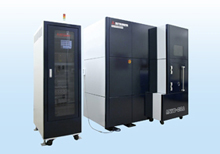
| Home | About Us | Contribute | Bookstore | Advertising | Subscribe for Free NOW! |
| News Archive | Features | Events | Recruitment | Directory |
News
22 July 2010
First direct bonding of SiC–Si and GaN–Si at room temperature
Tokyo-based machinery manufacturer Mitsubishi Heavy Industries Ltd (MHI) claims that it has achieved the world’s first direct bonding of silicon carbide (SiC) and gallium nitride (GaN) with silicon (Si), respectively, at room temperature. The company has also achieved direct bonding of sapphire with Si at room temperature.
Realized by an MHI-developed room-temperature wafer bonding machine that enables highly efficient, high-quality bonding of these materials, the firm reckons that the achievement opens up possibilities for various applications, as well as facilitating new device development while also enhancing productivity. Leveraging its Mitsubishi Bonding Support Program (MBSP), which supports users’ room-temperature wafer bonding manufacturing and product development activities, MHI aims to expand applications of room-temperature bonding to new fields.
MHI’s bonding machine uses a method to bond atoms of various materials at room temperature by activating the surface of the materials with ion beam radiation in a vacuum. It can bond various materials, for which optimized ion beam radiation (set according to the characteristics of each material) is a critical factor. Room-temperature bonding of SiC, GaN and sapphire, respectively, with silicon were achieved through optimized precise ion radiation. For all three materials, solid and rigid bonding has been confirmed, the firm adds.
 Picture: Mitsubishi Heavy Industries' room-temperature wafer bonding machine.
Picture: Mitsubishi Heavy Industries' room-temperature wafer bonding machine.
Due to its high-voltage durability and suitability for high-speed and high-efficiency switching, SiC has been in the spotlight for applications for next-generation power semiconductor devices, including as a component of inverters for electric vehicles. The application of GaN for blue LEDs, as well as high-frequency and low-loss power devices, has also been growing. Sapphire, which is growing in use as a material in optical devices, can also be used as a substrate for high-frequency circuits when bonded with silicon to produce silicon on sapphire (SOS).
By eliminating the heating process required in conventional heated bonding processes, room-temperature bonding not only frees devices from heat stress and strain, enabling rigid and highly reliable bonding, but also significantly reduces the processing time that previously included a heating/cooling cycle, says MHI. With these advantages significantly shortening production time and enabling a higher yield ratio, room-temperature bonding can realize reductions in device production costs, reckons MHI.
MBSP is a program to support users of MHI’s room-temperature bonding machine at each stage of development (conceptual design, functional prototype production, trial mass production and mass production). In implementing the program, MHI says that it will use its own engineers and facilities to liaise closely with customers and provide support relating to device bonding and evaluation.
MHI will exhibit samples of SiC–Si, GaN–Si and SOS at Micromachine/MEMS 2010 in Tokyo (28–30 July).![]()
Search: Wafer bonding
Visit: www.mhi.co.jp/en